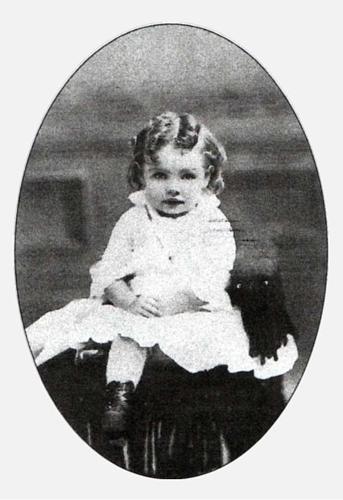Born in Tombstone, Arizona Territory, Aug. 16, 1881, Ethel Maud Robertson was a true Arizona pioneer. Her parents, Alice and Chris Robertson, had arrived in Tombstone from the mining settlement of Leadville, Colorado, the year before Ethel’s birth. The oldest of five children, Ethel took over running the household at age 14 after her mother died in 1895.
She spent one year attending the University of Arizona, but when her father was murdered during a shootout in Pearce in 1899, Ethel tried to become guardian of her two brothers and two sisters. Since she was not yet 21, however, she was made a ward of the court along with her siblings.
As soon as she reached the age of majority, Ethel assumed legal responsibility for the family. She and her 15-year-old sister, Edith, went to work recording tax rolls for the Cochise County Court House, the first women employed there. Ethel also took in boarders, especially children whose parents lived outside Tombstone and worked in the mines.
On Feb. 4, 1904, Ethel married Bert Macia, superintendent of the Tombstone Consolidated Mining and Milling Co. They had three children: Iris was born in 1908 followed by Jeanne in 1914 and James Herbert Macia, Jr. in 1916.
In 1919, Ethel convinced Bert they should purchase Tombstone’s Arcade Hotel and go into the boardinghouse business.
The Vizina Mining Co. had built the original adobe structure around 1878 to serve as an office and a boardinghouse. Newlyweds Henry and Mary Gee (Henry was the mining engineer of Vizina) stayed at the little hotel in 1885 while waiting for their new home to be finished. Mary’s Scottish family had sent her clippings of native plants to remind her of her homeland, including root cuttings from a white rose called the Lady Banksia Rose (banksiae alba-elena), named for Sarah Banks, wife of British naturalist and botanist Sir Joseph Banks. Mary shared her cuttings with the Vizina boardinghouse landlady, who planted the clippings in the hotel’s courtyard.
By 1884, the Vizina Mine was no longer productive and the building was sold. It first became the Cochise Hotel until new owners in 1900 christened it the Arcade Hotel and covered the outer walls with tin to protect the adobe from Arizona’s blistering sun.
Against Bert’s better judgment, Ethel took over the old Arcade Hotel and turned it into one of the most-sought-after attractions in Tombstone.
The original white rose bush that had been planted in the hotel’s courtyard continued to flourish. Bert and Ethel were constantly tying up the myriad branches that continued to grow and expand from its base. They built a wooden trellis for the plant, but the bush became so heavy they had to replace the trellis with wooden posts and metal pipe.
By 1936, the tree had become so large, its heavy branches filled with fragrant blossoming petals every spring, that Ripley’s Believe it or Not claimed it the world’s largest rose tree. Ethel realized the enticing draw she had for her hotel and renamed her establishment the Rose Tree Inn. She held court in the small patio that surrounded the rose tree, expounding on the history of the town and the roses.
Serving for 30 years on the board of the Arizona Children’s Home, Ethel was also a member of the Arizona Pioneer Historical Society and part of the initial planning for what is now Tombstone’s annual Helldorado celebration, serving on the first executive board in 1929 and becoming Queen of Helldorado at the age of 72 in 1953.
In 1955, the television program “Wide, Wide World” came to Tombstone to produce a live, nationwide show featuring the “Town Too Tough to Die.” Ethel, now the grande dame of Tombstone, dressed in her finest vintage gown, her feathered hat sitting snugly on her head.
She sat among the old timers buried in the Boothill Graveyard, recounting stories about those she had known and those she had only heard about. As a young girl on a trip with her mother to Colorado, she had met Tombstone legend Wyatt Earp. Her appearance on the show was a huge success.
In 1941, Ethel and Bert sold the Rose Tree Inn to their daughter Jeanne and her husband, who continued to live in the old adobe building.
During World War II, the inn became the meeting place for the Tombstone Hospital Auxiliary where women came to knit mittens, socks, and scarves for soldiers and discuss the war news — those who had made it home and those who had not. Bert, Jr. was “over there,” returning safely at the end of the war.
Jeanne and her husband made the Rose Tree Inn their home, ceasing operation of the hotel but keeping the rose tree patio open to the public. Edith continued to entertain visitors under the shade of the massive arbor.
In 1950, the Tombstone Restoration Commission was established to bring back the grandeur of old Western days, and to provide income for the dwindling population of Tombstone. Ethel became a charter member, serving as historian and a member of the governing board.
Ethel died Aug. 3, 1964. She spent her entire life in and around Tombstone and never wanted to be any place else.
Her legacy continues to grow outside the old Rose Tree Museum, where the flowers thrive and bloom every year from February through April. It continues to be considered the largest rose tree in the world.











